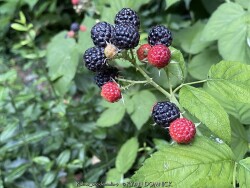

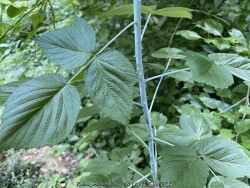
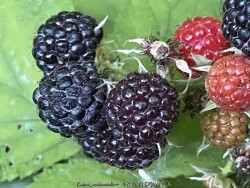
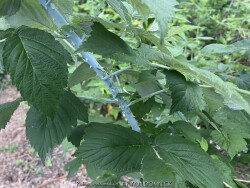
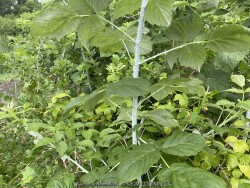
Plant Min Zone: 3a
Plant Max Zone: 8a
Sunlight: Full Sun, Part Sun, Shade
Water / Rainfall: Average, High
Soil Quality: Average
Bloom Season: Spring, Early Summer
Flower Color: White
Berry / Fruit Color: Red, Black
Spring Foliage Color: Green, Blue, Silver-Grey
Summer Foliage Color: Green, Blue, Silver-Grey
Fall Foliage Color: Green, Blue, Silver-Grey
Evergreen Foliage: No
Winter Interest: Some
Scented Flowers: No
Drought Tolerance: Medium
Wet-Feet Tolerance: Medium
Humidity Tolerance: Medium
Wind Tolerance: Medium
Poor Soil Tolerance: Clay Soils, Rocky Soils, Acidic Soil (low PH)
Height: 3' - 5'
Width: 3' - 5'
Growth Rate: Medium, Fast
Service Life: Long: 5-10 years
Maintenance Need: High
Spreading Potential: High
Yearly Trimming Tips: Prune Shrub Sparingly: Berry / Fruit Production Will be Reduced or Eliminated with Pruning: Blooms on Old Wood.
Plant Grouping Size: Small Grouping of 3-5, Medium Grouping of 5-10, Mass Planting of 10 or more
Best Side of House: South Exposure, East Exposure
Extreme Planting Locations: None
Ornamental Features: Easy to Eat Edibles
Special Landscape Uses: None
Possible Pest Problems: Insects, Disease, Herbivores
Plant Limitations: May get Occasional Winter-kill, Needs Regular Irrigation, Has Thorns, Needs Frequent Pruning / Trimming, Susceptible to Juglone / Black Walnut
Shippable in 2026: YES
Raspberry (Rubus occidentalis) is an "easy to grow" edible fruit that is worth growing in Kansas. Store-bought raspberries are expensive and don't taste as good as garden grown fruits. All cultivars of raspberries have perennial roots, but most top shoots only live for two years. (meaning shoots grow in the first growing season and fruits grow on those shoots during the second growing season) The cycle is repeated; maintenance involves removing old canes after decline or death. Raspberries are vigorous and can be locally invasive in the garden but rarely invasive in the wild. They propagate by basal shoots (also known as suckers) spreading some distance from the main plant. After establishment, it is high maintenance if it has already filled the space and you don't want it to spread any further so plan accordingly. In the landscape, raspberry and blackberry mix well into garden designs with ornamental plants as long as you create it's own area (like a background fence to train plants on) The main difference between raspberry and blackberry are that the fruit releases from the raspberry differently. The "torus" or inside center of the fruit is hollow and releases from the stem with raspberry. With Blackberry, the "torus" or center "picks with" the fruit giving a solid fruit to eat. (just in case you have always wondered) Native Black Raspberry (Rubus occidentalis) is a true native plant to Kansas lightly shaded woods, open moist prairies, disturbed areas (especially those that are logged or cut), and near streams and lakes, trails or roadways. Ripe fruit is black instead of red. Fruit production is rather brief compared to commercially available varieties (one big flush of fruits ripen for a couple weeks and that's it) Foliage is bluish-green with powdery white flocked backsides and irridescent bluish-purple stems add nice ornamental value! Also called black cap raspberry.